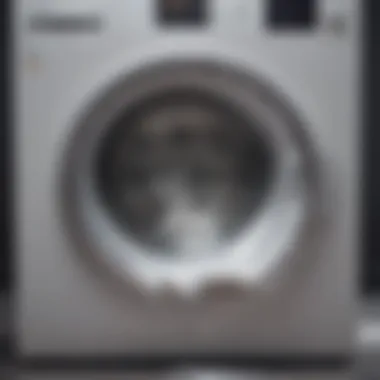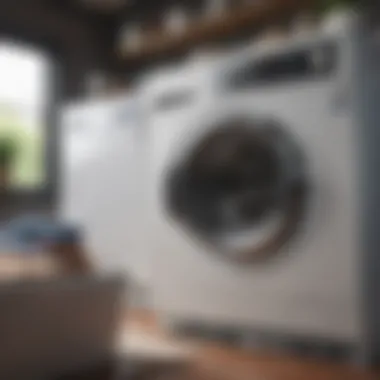How to Clean Your Laundry Machine with Baking Soda


Intro
Maintaining a laundry machine is essential for ensuring its efficiency and longevity. An often-overlooked cleaning agent is baking soda, a versatile and environmentally friendly material that can effectively break down grime, remove odors, and leave your machine in optimal condition. This article will guide you through the process of cleaning your laundry machine using baking soda and highlight why regular maintenance is important.
Cleaning your washing machine not only keeps it looking good but also enhances its performance. Dirt and detergent residue can build up over time, leading to unpleasant smells and affecting the washing process. By incorporating baking soda into your cleaning routine, you can avoid these issues while saving money on harsh chemicals and improving the lifespan of your appliance.
Cleaning Benefits
Using baking soda offers several advantages:
- Natural Cleaner: It contains no harmful chemicals, making it safer for household use.
- Deodorizer: It effectively neutralizes stubborn odors, leaving your laundry fresh.
- Cost-Effective: A low-cost solution for appliance maintenance, making it accessible for everyone.
Here are the key points we will cover:
- The materials needed for cleaning,
- A step-by-step process to clean your washing machine,
- Preventive measures to maintain efficiency over time.
Intro to Laundry Machine Maintenance
Maintaining your laundry machine is key to ensuring it operates efficiently and lasts longer. Regular cleaning not only enhances the performance, but it also minimizes the risk of mechanical issues and unpleasant odors. Since laundry machines work hard, they are prone to build-up of dirt, detergent residue, and mildew.
Importance of Cleaning Laundry Machines
Cleaning your laundry machine is essential for several reasons. First, it prevents the accumulation of grime that could lead to malfunctions. A clean machine operates better, saving you time and potentially avoiding costly repairs. Furthermore, keeping the washer clean improves the effectiveness of your laundry. Dirty machines can lead to unsatisfactory wash results, leaving clothes less than fresh.
Additionally, maintenance of your laundry machine contributes to healthier living conditions. Bacteria and mold thrive in damp, neglected environments. Without proper cleaning, these microorganisms can transfer to the laundry, jeopardizing your family's health. By routinely maintaining the machine, you can enhance hygiene while protecting the integrity of the fabrics you wash.
Signs Your Laundry Machine Needs Cleaning
It is not always easy to tell when your laundry machine requires attention. However, several indicators can alert you to the need for cleaning. Common signs include:
- Odors: Unpleasant smells emanating from the washer indicate mold or mildew growth.
- Residue build-up: If you see detergent residue or fabric softener remnants, it is time to clean.
- Stains on clothes: If clean clothes emerge with stains, it could be a sign of a dirty drum.
- Unusual noises: Grinding or rattling sounds may indicate foreign debris inside the machine.
Recognizing these signs early can save you from bigger issues down the track. Regular cleaning is a proactive approach that ensures your laundry machine operates at its best.
Understanding the Role of Baking Soda
Baking soda plays a vital role in the process of cleaning laundry machines. Its effectiveness in breaking down residues, odors, and stains elevates its status as a preferred cleaning agent. By exploring the many aspects of baking soda, one can appreciate why it is frequently recommended for maintaining the cleanliness and efficiency of washing machines.
Chemical Properties of Baking Soda
Sodium bicarbonate, commonly known as baking soda, is a simple chemical compound. Its basicity, which allows it to neutralize acids, makes it an ideal cleaner. When mixed with water, baking soda dissociates into sodium ions and bicarbonate ions, creating an alkaline solution. This alkaline nature helps to cut through grease and grime that can accumulate in laundry machines over time. Additionally, its mild abrasive quality aids in scrubbing away stubborn deposits without damaging surfaces. The effectiveness of baking soda in dealing with mineral deposits makes it particularly valuable in areas with hard water.
Benefits of Using Baking Soda in Cleaning
Using baking soda for cleaning offers numerous benefits:
- Deodorizing Properties: Baking soda absorbs unpleasant odors, effectively neutralizing them rather than just masking them.
- Eco-Friendly Alternative: Unlike some commercial cleaners, baking soda is non-toxic and safe for the environment, making it a sustainable choice for households.
- Cost-Effective Solution: Baking soda is inexpensive and readily available, providing a budget-friendly option for cleaning needs.
- Versatility in Use: Beyond laundry machines, baking soda serves various purposes in home cleaning routines, from deodorizing carpets to polishing surfaces.
"Employing baking soda not only facilitates cleaner laundry machines but also supports a broader commitment to environmentally conscious habits in domestic settings."


In summary, understanding the role of baking soda in the cleaning process is essential for effective laundry machine maintenance. Its chemical properties provide a foundation for its functions, while the numerous benefits ensure that it remains a go-to option for homeowners aiming for a cleaner, fresher machine.
Essential Supplies for Cleaning
The cleaning process of a laundry machine can only be effective if the right supplies are used. Understanding the essential supplies will not just streamline the cleaning but also enhance the effectiveness of the materials employed. The following ingredients are fundamental in utilizing baking soda to achieve a well-maintained machine.
Materials Needed
Baking Soda
Baking soda is a cornerstone in the cleaning process. Its primary contribution lies in its mild abrasive quality and alkaline nature, which help break down grime and eliminate odors. An important characteristic of baking soda is its versatility; it can effectively combat stains and neutralize unpleasant smells. This makes it a popular choice for cleaning laundry machines. The unique feature of baking soda is its ability to react with acids in stains, lifting them away from surfaces without causing damage. However, its sole usage may not be sufficient for heavy build-up; hence it is usually combined with other agents, like vinegar.
White Vinegar
White vinegar acts as an excellent complementary agent in cleaning routines. Its key characteristic is its acidic composition which helps dissolve mineral deposits and soap scum. White vinegar is beneficial as it not only cleans but also deodorizes the machine. When paired with baking soda, vinegar can amplify the cleaning effect due to their contrasting chemical properties. Its unique feature lies in its ability to break down residue left behind by detergents. However, vinegar should not be used excessively as it can wear down rubber seals in the machine.
Microfiber Cloths
The role of microfiber cloths in this cleaning process is significant. Their primary aspect is the fiber construction, which traps dirt and absorbs moisture more effectively than standard cloths. Microfiber cloths are popular because they provide a gentle but effective cleaning of surfaces. The unique feature of microfiber is its ability to capture particles as small as 0.1 micron. This cleaning capability ensures that dust and grime do not get redeposited elsewhere. Although their initial cost may be higher, their longevity and effectiveness make them a worthwhile investment.
Toothbrush
A common tool like a toothbrush finds its place in deep cleaning efforts. What makes it vital is its small bristles that can reach crevices and tight spaces where dirt may build up. Its key characteristic is the ability to scrub without scratching delicate surfaces. This makes a toothbrush a beneficial choice for detailed cleaning in hard-to-reach areas. The unique feature of a toothbrush is its ergonomic design, which provides significant control while cleaning. A downside is that it requires manual effort, thus might be less desirable for large areas.
Safety Precautions
When engaging in any cleaning task, safety should always be a priority. Using cleaning supplies properly and ensuring ventilation can help avoid potential harm. Ensure to wear gloves while handling any chemical materials and keep all products and tools out of reach of children. Always read labels for any specific safety information related to cleaning agents.
Step-by-Step Cleaning Process
Cleaning your laundry machine using baking soda involves a step-by-step approach. Understanding this process is crucial as it ensures that you effectively eliminate any build-up and improve your machine's performance. This systematic method not only enhances the efficiency of the appliance but also prolongs its lifespan. Following each step carefully allows you to address specific issues such as odors or residues that may linger, ultimately leading to a fresher laundry experience.
Preparing the Machine
Emptying the Drum
Emptying the drum is fundamental to the cleaning process. Before starting with any cleaning agents, removing all clothing and items from the washer is critical. This action prevents any interference or blockage during the cleaning process. The key characteristic of this step is that it creates a clean slate, allowing for unobstructed access to the interiors. Moreover, emptying the drum reduces the risk of residue mixing with your cleaning solution, ensuring a more effective cleanse.
Another important feature is that this practice helps in identifying any hidden items or potential damages that require attention. While commonly overlooked, this step is a beneficial choice in thorough cleaning, promoting a higher level of hygiene.
Checking for Lint and Debris
Checking for lint and debris in the machine is equally significant. After emptying the drum, look for any debris that might be trapped inside. This inspection contributes directly to the overall goal of ensuring the machine operates smoothly. By removing any accumulated lint, hair, or small objects, you effectively reduce the risk of clogs.
The key characteristic of this step lies in its preventive approach. Regularly checking for debris helps to maintain the efficiency of the washer and mitigates the chance of more serious mechanical issues. This is a beneficial practice that enhances overall cleanliness and hygiene standards, making it a unique feature in the cleaning process.
Applying Baking Soda
Mixing Baking Soda with Water
Mixing baking soda with water is a significant step in this cleaning process. Combining these ingredients creates a paste that serves as an effective gentle abrasive. This mixture contributes to the goal of eliminating stains and odors. The key characteristic of this combination is its dual-action; while baking soda acts to neutralize odors, the water helps distribute it evenly throughout the interior surfaces. This is a popular choice as many homeowners seek natural cleaning solutions.


A unique feature of this process is the ease of creating this mixture. You simply need equal parts of baking soda and warm water, making it a straightforward task. One consideration is to avoid using excessive amounts of water, which might dilute the potency of baking soda's cleaning properties.
Distributing the Mixture
Distributing the mixture effectively across the machine surfaces plays a crucial role in the cleaning process. This ensures that every area, including the drum and door seals, receives adequate treatment. The key characteristic of this step is thoroughness. An even distribution allows for uniform cleaning, which enhances the overall effectiveness of the process.
When applying the mixture, it is beneficial to use a cloth or sponge to reach those hard-to-clean edges. This unique approach ensures that no area is left untreated. While a downside could be the time taken to distribute it perfectly, the advantage lies in the results you will see afterward.
Utilizing White Vinegar
Adding Vinegar to the Drum
Adding vinegar to the drum is a key action after applying baking soda. White vinegar complements the cleaning process by further sanitizing and deodorizing the machine. This step is beneficial as it helps break down any remaining residues or build-up, enhancing the effectiveness of the first round of cleaning. The unique feature of vinegar is its acidity, which effectively combats stains and odors that baking soda alone might not eliminate.
This makes it a popular choice for many looking to ensure a thorough clean, as it is safe for the environment and the machine. One consideration is to use vinegar judiciously; excessive amounts may lead to excess foam during the clean cycle, which can create issues.
Running a Hot Cycle
Running a hot cycle after adding vinegar is essential. This cycle allows the ingredients to work together effectively, ensuring that any remaining grime is dissolved. The importance of this step is significant, as it utilizes heat to activate the cleaning agents present in both baking soda and vinegar.
The unique feature of this method is that it not only cleans but also disinfects, making it more than just a surface clean. While using hot water is beneficial, it is important to check the machine's manual for temperature limits to avoid any damage.
Cleaning Exterior Surfaces
Using Microfiber Cloth
Using a microfiber cloth to wipe down the machine's exterior is vital for comprehensive cleaning. This step contributes to the overall goal of maintaining a clean appliance, reducing dust and smudges. The key characteristic of microfiber cloths is their effective cleaning ability without scratching surfaces.
This makes it a valuable choice for many homeowners looking for gentle yet effective cleaning materials. The unique feature of microfiber is that it can trap dirt particles, providing a more thorough clean. One consideration is to ensure the cloth is damp, which enhances its ability to capture dust.
Focusing on Control Panels and Hoses
Focusing on control panels and hoses during the cleaning process is crucial in addressing areas that often accumulate dirt and grime. This aspect is key in ensuring the machinery remains functional and aesthetic. The unique feature of this focus is that it targets high-use areas which may harbor bacteria or retain moisture, posing risks of malfunctions.
This step is beneficial as it not only improves the machine's appearance but also ensures its operational efficiency is not compromised. Care should be taken to avoid harsh cleaners on control panels, which may damage the finish.
Overall, following this structured cleaning process enhances the longevity and effectiveness of your laundry machine. By giving attention to each step from preparation to final touches, you maintain not only a cleaner machine but also a more efficient one.
Aftercare and Maintenance
Maintaining a laundry machine after cleaning is as crucial as the initial cleaning process. The significance of aftercare lies in ensuring that the machine's efficiency remains at optimal levels. Regular upkeep prevents buildup of residues, bacteria, and mold. If ignored, these issues can lead to unpleasant odors, reduced washing effectiveness, and even potential machine failure. Therefore, adopting a routine for aftercare will not only prolong the life of the appliance but also provide better laundry results.
Preventing Future Build-up
To combat future grime and bacteria, there are several proactive measures homeowners can take:
- Leave the Door Open: After a wash cycle, keep the door ajar. This allows air circulation, which helps dry any moisture inside the drum.
- Wipe Down Gaskets: A simple swipe of a microfiber cloth around the rubber gasket can eliminate moisture and prevent mold from growing.
- Use Less Detergent: Overusing detergent can leave residue. Measure the amount accurately to avoid excess buildup.
- Occasional Vinegar Rinse: Running a hot wash with white vinegar every few months can help maintain cleanliness.
By incorporating these actions into your routine, you can deter future build-up and maintain a cleaner machine.


Regular Cleaning Schedule
Establishing a cleaning schedule is essential for any effective maintenance strategy. A consistent routine ensures that the machine stays clean and functional. Here are some recommended timeframes:
- Monthly: Perform a thorough cleaning using baking soda and vinegar. This should include all aspects mentioned previously.
- Weekly: After each wash, quickly wipe the exterior surfaces and check for residual laundry detergent or fabric softener.
- Bi-Annually: Focus on a more detailed assessment of the machine, including checking hoses and inspecting for any wear and tear.
A well-defined cleaning schedule can significantly enhance the lifespan and performance of your laundry machine, ensuring it operates at its best for years to come.
"Regular maintenance not only improves efficiency but also saves money in repairs in the long run."
Troubleshooting Common Issues
Cleaning your laundry machine with baking soda is an effective measure for maintenance. However, sometimes problems persist even after cleaning. This section focuses on troubleshooting common issues, such as lingering odors and stubborn stains. Properly addressing these concerns ensures the machine operates efficiently and prolongs its lifespan.
Odors Persisting After Cleaning
Despite your best efforts with baking soda and white vinegar, you may still sense undesirable odors emanating from your laundry machine. Several factors can contribute to this issue. First, moisture can build up in hidden areas of the machine. This damp environment encourages the growth of mold and mildew. Addressing this requires checking and cleaning the gasket and drain pump filter. Wipe down these areas with a solution of baking soda and warm water.
Another possible cause is using too much detergent. Excessive detergent may not rinse out fully, leading to a residue that traps odors. Always follow the manufacturer’s recommendations for detergent use.
To combat persistent smells, you can:
- Run a hot water cycle: Add two cups of baking soda directly into the drum. This can help eliminate built-up residues.
- Leave the door open: After cycles, keeping the door ajar allows moisture to dissipate, preventing mildew growth.
- Use scented cleaning agents: Occasionally, you may want to include a scented laundry cleaner to eliminate the smell.
"Regular maintenance is key to avoiding unpleasant surprises in your laundry routine."
Stains Remaining
Stains on the drum or interior parts of the laundry machine can be frustrating. These marks may result from fabric dyes or residues left over from previous washes. Properly addressing these stains is essential for both aesthetics and functionality.
Start by identifying the nature of the stains. For example, fabric dyes may need special care. In such cases, a concentrated solution of baking soda mixed with water can be effective. Apply this paste directly to the stained areas. Allow it to sit for about 30 minutes before scrubbing gently with a toothbrush. Rinse thoroughly with a damp cloth afterward.
For grease or oil stains, use a mixture of baking soda and dish soap for enhanced cleaning. This combination works best as it breaks down oily residues effectively.
Additionally, ensure:
- Regular cleaning: Include the drum in your regular maintenance routine to prevent stain build-up.
- Use hot water cycles: Occasionally run a hot cycle to help remove aggressive stains.
- Inspect laundry before washing: Check clothing items for stains before loading them into the machine.
Maintaining a schedule for these tasks can significantly reduce the occurrence of odors and stains. Thus, you will enhance both the appearance and performance of your laundry machine.
Culmination
Cleaning your laundry machine is essential for maintaining its longevity and efficiency. In this article, we discussed how to effectively use baking soda as a cleaning agent. The steps outlined show that a few basic materials can yield significant benefits, such as improved machine performance and odor elimination. Regular maintenance protects your investment and ensures clean laundry every time.
Recap of Cleaning Steps
To summarize, the cleaning process can be broken down into key actions:
- Preparing the Machine: Start by emptying the drum and checking for lint or debris.
- Applying Baking Soda: Mix baking soda with water and evenly distribute it in the drum.
- Utilizing White Vinegar: Follow with adding white vinegar and running a hot cycle to enhance cleaning.
- Cleaning the Exterior: Wipe down with a microfiber cloth, paying attention to control panels and hoses.
These steps are straightforward yet effective in restoring your laundry machine to working order.
Final Thoughts on Maintenance
- Schedule cleaning every few months.
- Stay aware of signs that indicate your machine requires immediate attention.
By practicing these maintenance tips, users can enjoy the benefits of a well-functioning laundry machine and the satisfaction of cleaner clothes. For detailed cleaning methodologies, visit Wikipedia or gain more insights on appliance care through platforms like Reddit.















